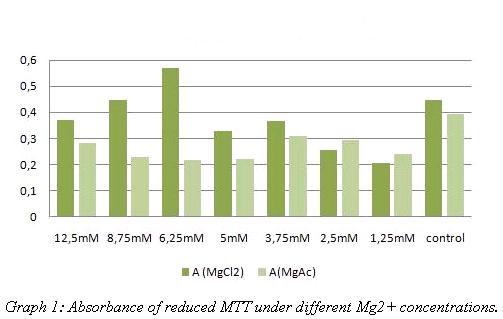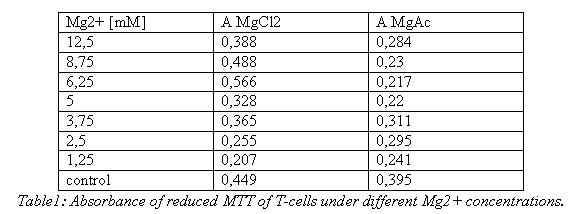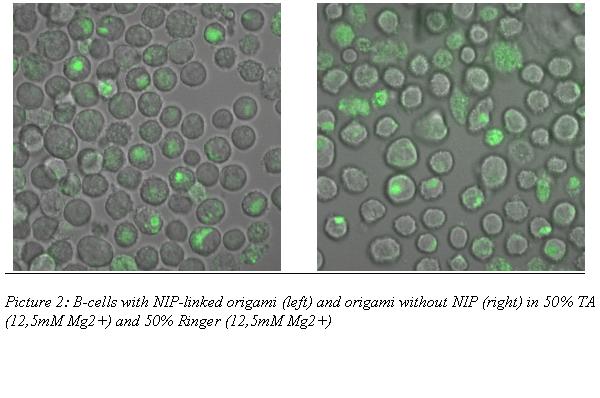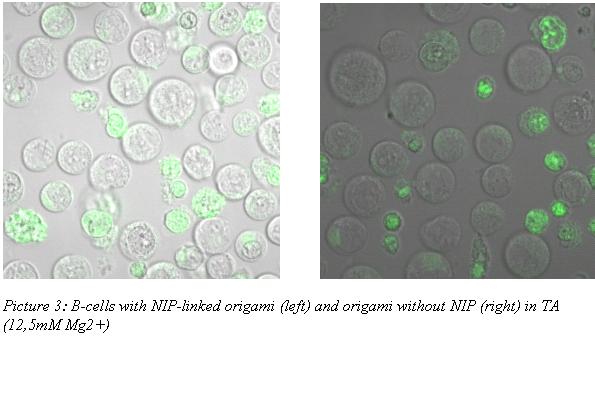|
Home
The Team
Project Report
Parts
Modeling
Notebook
Safety
CoLABoration
|
_cell culture
Introduction:
Besides the project with the artificial receptor system, it was also tried to activate t-cells (B12.7.5) and b-cells (j558lδmmb1nfleck) with the NIP-linked DNA-origami. Both cell-types have a anti NIP Fab-fragment linked to their receptor. During these tries many problems were faced which could emerge as obstacles in the main project, the artificial receptor which is expressed by 293t-cells.
The first problem was the media. The cells were normally kept in Ringer solution during the first measurements which contains too little Mg2+ to keep the origamis stable. So the Mg2+ tolerance of the cells had to be tested in the hope the origamis would be stable if we add Mg2+ to the buffer.
Additionally the 293t-cells were tested on their tolerace to TA-buffer in which the origamis are stored.
Since the binding between Fab-fragment and NIP is essential for coupling of the receotors, Alexa 488 linked origamis with and without NIP were given to the cells to detect the binding and the fluorescence was visualized with a LSM.
Materials and methods:
Mg2+ tolerance tests
T-cells:
To test the Mg2+ tolerance of the T-cells, 800µl RPMI medium was mixed with 100µl cellsuspension and 100µl MgCl2/MgAc Solution with different concentrations and given to a 24-well plate. Because a qualitative result seemed to be sufficient, seeding the cells was done without counting them before. 3 days later the cells of each well were spun down, the supernatant was discarded and the cells were resolved in 200µl new RPMI medium. Additionally 50µl MTT was added to each sample. After 4h of incubation at 37°C the cells were spun down again and after discarding the medium the pellet was resolved in 400µl DMSO and 50µl Soerensens’ reagent. The reduced blue MTT was detected in the photometer at 570nm.
B-cells:
B-cells of an 10ml dish were spun down and resolved in 9ml Ringer (+12,5mM MgAc). After incubation for 45min the cells were spun down again and resolved in 1ml PBS. 5µl of the suspension was mixed with 45µl Trypan blue and the cells were counted in a “Neubauer cell chamber”. Since the dye can’t penetrate cells with active inner membrane potential, only dead cells got stained with this method.
293t-cells:
The cells were scraped off an 10ml dish, spun down and resolved in 10ml new DMEM medium. 500µl of this suspension was given in each plate of a 6-well plate containing 4500µl DMEM medium with different concentrations of Mg2+. 3 days later the media of 3 wells was sucked off and the cells were washed in PBS, then TA-buffer was given to these wells. After 1h the TA-buffer was removed, the cells of all dishes were washed in PBS and 2ml new DMEM medium plus 500µl MTT was added. After incubation for 3,5h at 37°C the cells were scraped off the wells and spun down at 13000 rpm for 5min. Then the pellet was resolved in 4ml DMSO and 500µl Soerensens’ reagent. Detection took place at 570nm.
Detection of the receptor-NIP linkage
To test the linkage between origamis and t-cells/b-cells, 15µl cell suspension in Ringer (12,5mM Mg2+) or TA-buffer (12,5mM Mg2+) was mixed with 15µl of origamis on a IBIDI µ-Slide. The linkage was regarded using a LSM.
Results:
Mg2+ Tolerance tests:
T-cells:


B-cells:
Counting stained and unstained B-cells brought following result:
Dead cells : 1
Living cells: 44
Total cell number: 45
293t-cells:

Detection of the receptor-NIP linkage


Discussion:
Mg2+-tolerance-tests
The MTT assays and the trypan blue staining proofed the tolerance of the used cells towards a concentration up to 12,5mM Mg2+. This is the exact concentration in which the origami are produced and stored. The lower absorbance in the tests with TA could possibly come from the removal of the TA-buffer because it seemed that the TA buffer disturbs the adhesion of the 293t cells to the ground of the well so that some cells might be sucked off with the TA.
Detection of the receptor-NIP linkage
During the binding measurements it seemed that the origamis were absorbed by the cells or that they bind unspecifically. Later tests at the AFM showed no functional origami which could be an explanation to the behaviour of the cells. The expanded form of the b-cells in TA-buffer showed that sole TA-buffer is osmotically disadvantageous for the cells.
Media:
B- and T-cell medium consists of:
- RPMI
- 10%FCS
- HEPES (10mM)
- β-mercaptoethanol (50µM)
- L-Glutamine (2mM)
- 1%Pen-Strep
293t media cosists of:
- DMEM
- 10% FCS
- 5% PenStrep
- L-Glutamine (1,5mM)
|
 "
"





